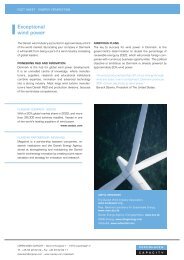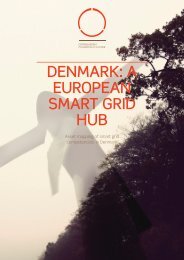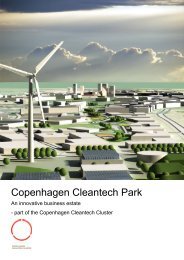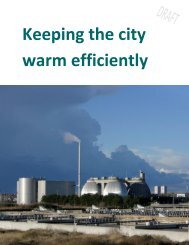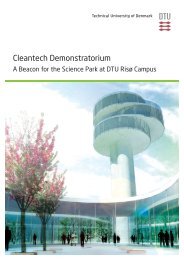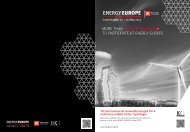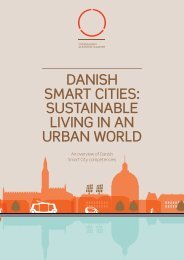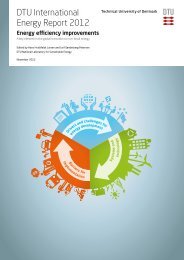Future low carbon energy systems - Copenhagen Cleantech Cluster
Future low carbon energy systems - Copenhagen Cleantech Cluster
Future low carbon energy systems - Copenhagen Cleantech Cluster
You also want an ePaper? Increase the reach of your titles
YUMPU automatically turns print PDFs into web optimized ePapers that Google loves.
Catalogue of <strong>energy</strong> technologies4plants, combined heat and power cogeneration, and anMHD topping cycle. The MHD (magnetohydrodynamic)generator converts thermal <strong>energy</strong> or kinetic <strong>energy</strong> directlyinto electricity. MHD generators can operate at hightemperatures without moving parts. The exhaust of a MHDgenerator is a flame, still able to heat the boilers of a steampower plant. So high-temperature MHD could be as a toppingcycle to increase the efficiency of electric generation,especially when burning coal or natural gas. This technologyis still far from commercial status.-has grown rapidly since the 1980s because it is relatively superiorto other fossil-fuel technologies in terms of investmentcosts, fuel efficiency, operating flexibility, rapid deploymentand environmental benefits, especially when fuel costswere relatively <strong>low</strong>. Combined cycle gas turbine (CCGT)plants produce less CO2 per unit <strong>energy</strong> output than coalor oil technologies, because of the higher hydrogen-<strong>carbon</strong>ratio of methane and the relatively high thermal efficiency ofthe technology [9].Conventional oil products extracted from crude oil-wellbores and processed by primary, secondary or tertiary methodsrepresent about 37% of total world <strong>energy</strong> consumptionwith major resources concentrated in relatively fewcountries. Assessments of the amount of oil consumed, theamount remaining for extraction, and whether the peak oiltipping point is close or not, have been very controversial.ventionalliquid fuels, i.e. oil that requires extra processing(heavy oils, oil (tar) sands or from shales), will then becomemore economically attractive. Resource estimates are uncertain,but together contributed around 3% of world oil productionin 2005 (2.8 EJ) and could reach 4.6 EJ by 2020 andup to 6 EJ by 2030 [9].4.1.7 CombustionDirect combustion of fuels may in principle occur in oneof the fol<strong>low</strong>ing technologies; fixed-bed firing on a grate,fluidized bed combustion or (co-)firing in suspension. Eachof these technologies poses different characteristics and iswell-suited for fuels of quite different physical and chemicalcomposition. In order to increase the total plant efficiency,most modern boilers (except for waste incinerators outsideof Europe and Japan) produce both heat and power.An <strong>energy</strong>-efficient way of using coal for electricity productionwould be via solid oxide fuel cells or molten <strong>carbon</strong>atefuel cells (or any oxygen ion transport based fuel cell that donot discriminate between fuels, as long as they consume oxygen),which would be able to reach 60%–85% combined efficiency(direct electricity + waste heat steam turbine). Currentlythese fuel cell technologies can only process gaseousfuels, furthermore they are sensitive to sulfur poisoning; thisoperational problem must be solved before large scale commercialsuccess is possible with coal. As far as gaseous fuelsgo, one possible solution is pulverized coal in a gas carrier,such as nitrogen. Another option is coal gasification withwater, which may <strong>low</strong>er fuel cell voltage by introducing oxygento the fuel side of the electrolyte, but may also greatlysimplify <strong>carbon</strong> sequestration.4.1.8 GasificationIndustrial-scale gasification is currently mostly used toproduce electricity from fossil fuels such as coal, where thesyngas is burned in a gas turbine. Four types of gasifier arecurrently available for commercial use: counter-currentfixed bed, co-current fixed bed, fluidized bed and entrainedf<strong>low</strong>. Gasification is also used industrially in the productionof electricity, ammonia and liquid fuels (oil) via IntegratedGasification Combined Cycles (IGCC), with the possibilityof producing CH4 and H2 for fuel cells. IGCC is also a moreefficient method of CO2 capture as compared to conventionaltechnologies. IGCC demonstration plants have beenoperating since the early 1970s and some of the plants constructedin the 1990s, are now entering commercial service.In the early research stage is microbes for the in-situ-coalmining producing methane as a product of digestion.4.1.9 Reduction of emissions X- and SOX-removal from fluethe preferred technologies are selective catalytic reductionXproducing SO2 reduction by limestone.Reductions in CO2 emissions can be gained by improving theefficiency of existing power generation plants by employingmore advanced technologies using the same amount of fuel.For example, a 27% reduction in emissions (gCO2/kWh) ispossible by replacing a 35% efficient coal-fired steam turbinewith a 48% efficient plant using advanced steam, pulverizedcoaltechnology. Replacing a natural gas single-cycle turbinewith a combined cycle (CCGT) of similar output capacitywould help reduce CO2 emissions per unit of output byaround 36%. Switching from coal to gas increases the effi-Risø Energy Report 721





